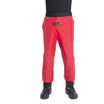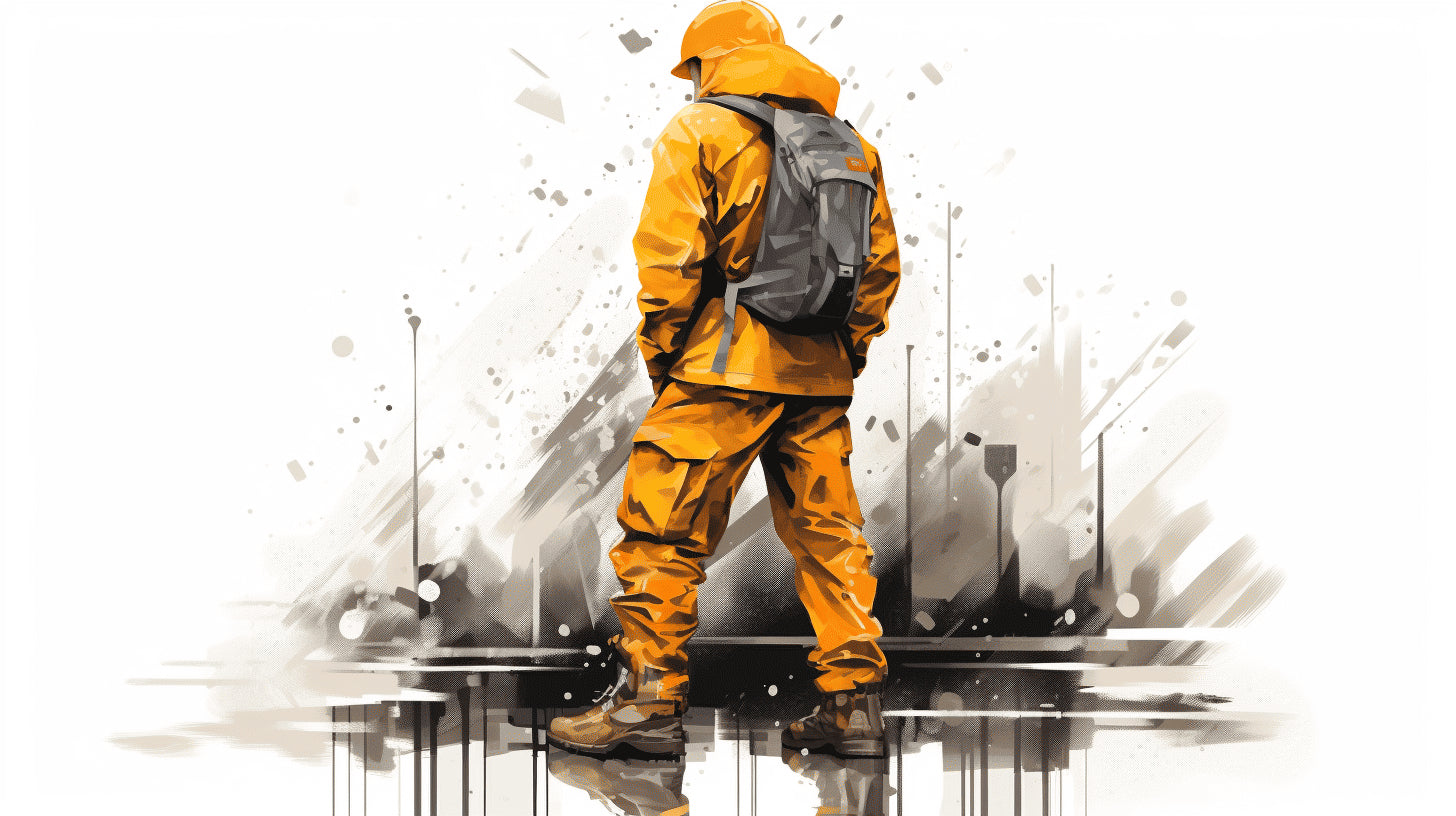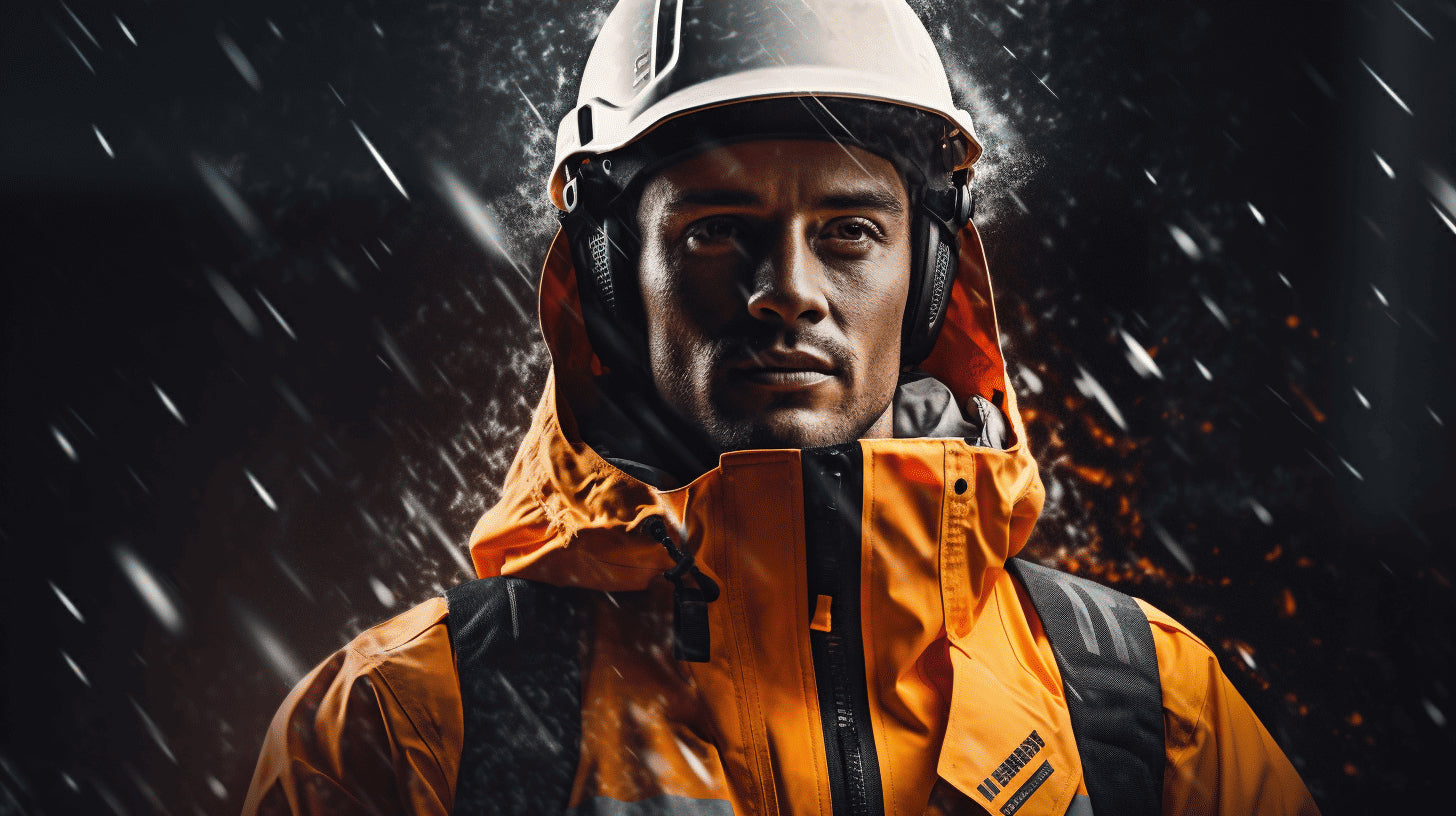When you’re part of the construction industry, the weather doesn't always cooperate with your plans. Storm clouds rolling in might signal a thrilling finale on a movie set, but they're less welcome when you're exposed to the elements on a construction site. Rain can slow down your progress, create potential safety hazards, and rob your team of the motivation harder than a taskmaster with a whip. However, with the right rain gear, you can turn the tables on the weather and keep your project moving ahead.
In this article, we will be delving deeper into the importance of investing in quality rain gear for construction work. We'll look at what features you should expect from a high-quality rain gear, the impact of rain gear on the global market, as well as different types suitable for construction work. We will also provide some handy maintenance tips to ensure your gear remains durable and effective in even the harshest weather conditions. Nestled between hardhats and hammers, rain gear may not be the first piece of equipment that comes to mind when getting ready for a day's work. However, remember it's not only an essential but also an investment in comfort, safety, and productivity.
The Importance of Durable Rain Gear for Construction Work
When it comes to outdoor work, especially in the construction industry, the wear-and-tear on your clothing can be just as intense as the physical demand of the job. In light of this, investing in high-quality, durable rain gear becomes essential. Despite the best weather predictions, conditions can change rapidly, and finding yourself soaked to the bone on the job can not only be uncomfortable, but it can also dramatically impact your productivity and safety. So why is it so important to have durable rain gear for construction work?
One of the main reasons is that quality rain gear offers protection from harsh weather conditions. Construction work doesn't stop because of a little rain, and the right gear can keep you dry and warm even when conditions are less than ideal. Whether it's a lightweight, water-resistant jacket for those drizzly days or a heavy-duty, waterproof ensemble for a downpour, having top-notch rain gear at your disposal ensures you’re ready for anything.
Additionally, durability in rain gear often equates to better longevity, making your initial investment worthwhile. When you factor in the rough nature of construction work and the high potential for wear and tear on your clothing, durable rain gear offers a cost-effective solution. Instead of replacing cheaply made jackets and overalls every few months, invest in sturdy gear that will stand the test of time.
- High-quality rain gear provides excellent protection against harsh weather conditions.
- Durable rain gear offers a longer lifespan, reducing replacement costs.
Furthermore, the right rain gear can significantly improve your comfort and efficiency on the job. Staying dry in wet weather not only keeps you comfortable, but it also reduces the risk of issues like skin irritations, chafing, and even hypothermia. Moreover, lightweight and flexible rain gear allow you to move freely, ensuring your performance doesn't suffer despite adverse weather.
- Quality rain gear enhances comfort and safety during work.
- Tailored gear supports efficient movements and work productivity.
Without a doubt, the importance of durable rain gear for construction work can’t be overstated. With consistent search trends for durable rain gear in the construction field, it is clear that the demand for such products is on the rise. In the face of unpredictable weather, having reliable and sturdy rain gear is a small pricing pay for the immense benefits it brings to the table. Stay dry, stay safe, and maintain maximum productivity with excellent, durable rain gear specifically designed for the rigors of construction work.
Features of High-Quality Rain Gear
Rain, a refreshing natural occurrence, sometimes transforms into a major hassle—especially for outdoor enthusiasts. The importance of having high-quality rain gear cannot be overstated as it can significantly change the experience of being outdoors in unfavorable weather. With myriad choices available, determining the quality of rain gear can be quite challenging. But don't fret, we've got you covered. Let's delve into the key features of superior rain gear that could be your savior during your next encounter with a storm.
Waterproof Rating
When a raindrop hits the ground at a whopping 20 miles per hour, it's no surprise that a high-quality rain jacket requires a waterproof rating of around 20,000 mm. Even during severe weather conditions, this impressive rating is the boundary line between being soaked to the bone and staying comfortably dry. A waterproof rating is essentially a measure of how resistant the fabric is to water, particularly under pressure. The higher the number, the greater its ability to repel water, thus offering superior protection.
Fabric Liner
Another fundamental feature is the fabric liner, which acts as a critical defense layer against rain. Not just providing waterproofing, the fabric liner enhances comfort and durability. It prevents moisture buildup inside the jacket, keeping you dry and cozy during your rainy escapades. So, when choosing your gear, an essential consideration should be a jacket with a high-quality fabric liner.
PFC-free Treatment
Elevating the water-repellency of high-quality rain gear is the Perfluorocarbons (PFCs) free treatments. PFCs, though highly effective at creating water-resistant barriers, have raised environmental concerns due to their non-biodegradable nature. However, with advancements in technology, PFC-free treatments have emerged, offering outstanding waterproof performance without the negative environmental impact. Ultimately, PFC-free treatments are a win-win, providing excellent protection from the rain while keeping the environment in mind.
PU Coating
Polyurethane (PU) coatings work wonders in enhancing the water-repelling properties of your rain gear. They serve as an additional waterproof layer, which is important when you're dealing with downpours or wet snow. The PU coating maintains its waterproof characteristics even in harsh conditions and provides warm insulation. So, if you're planning an adventure in cold rainy climates, gear with a PU coating is a match made in heaven.
Durable Water Repellent Coatings
Lastly, durable water-repellent (DWR) coatings play an essential role in the performance of high-quality rain jackets. These coatings cause the water to bead up and roll off the fabric, keeping you dry in the process. And the best part- DWR coatings maintain the breathability of the jacket, ensuring you stay comfortable, even during strenuous activities.
Rain cannot dampen your spirits if you gear up right. High-quality rain gear consists of these essential features— an impressive waterproof rating, a robust fabric liner, environmentally friendly PFC-free treatments, a handy PU coating, and efficient DWR coatings. These must-have components not only ensure you stay dry but also add to your comfort, making your adventures in the rain an experience to remember. So, the next time you plan your outdoor escapades, don't forget to pack your high-quality rain gear.
The Impact of Rain Gear on the Global Market
If you've ever found yourself caught in a sudden downpour, you'd agree that a durable, waterproof raincoat or umbrella can be a game changer. However, have you ever considered what it means for the global market? Interestingly, rain gear does not only have profound effects on personal convenience, but also on the world of international commerce.
Rain gear, including items like raincoats, umbrellas, waterproof shoes, children's rain sets, and more, constitutes an important segment of the outdoor apparel industry. This industry has seen significant growth in recent years. In fact, it's projected that the rainwear market will register a Compound Annual Growth Rate (CAGR) of an astonishing 6.2% by 2030. Drivers behind this trend are diverse, ranging from lifestyle shifts inclined towards outdoor activities, to increasing awareness about protection against harsh weather conditions.
The ascending trend of outdoor activities and eco-tourism is inducing a surge in the demand for rainwear. People are now more engaged in outdoor sports, hiking, mountain climbing, or camping than they were previously, thereby increasing the need for weather-appropriate gear. This heightened demand, quite logically, translates into increased market growth.
Increasing climate awareness is also playing a key role. More and more people are understanding the importance of weather-protective clothing as a way to mitigate extreme weather conditions brought on by climate change. This increased consciousness is reflected in the growing demand for comprehensive rain gear internationally.
However, as robust as the growth may be, the market is not without its challenges. For instance, the high cost of high-quality, waterproof materials can be a deterrent for consumers, potentially hindering market growth. But even with these obstacles, one can't deny the market's global potential.
Gazing into a future where climate change and sustainable living continue to dominate global discourse, the market for rain gear is expected to display greater strength and resilience. To make matters more interesting, further advancements in rain gear technology will likely further stimulate growth.
So, the next time you're headed out to brave a rainy day with your gear appropriately chosen, take a moment to appreciate the umbrella or raincoat in your hand. It is, after all, a small but significant testament to a thriving global market that's working towards making our lives a little more comfortable, one rainy day at a time.
Types of Rain Gear for Construction
When working on a construction site, weather unpredictability can often be a challenge. Be it a sudden downpour or a persistent drizzle, having the right rain gear can make all the difference. So, what are some of the best types of rain gear for construction?
Breathable Nylon and Polyester Rain Gear
First off, we have the breathable nylon and polyester rain gear. These materials are developed with a special coating that repels water while allowing sweat vapors to escape. This means you can work comfortably without getting soaked, either from rain or from your own perspiration. The wonders of science!
- Durable
- Water-repellent
- Breathable
- Lightweight
This type of rain gear is a popular choice among construction workers for its balance between protection and comfort.
Rain Jackets With Three-Layer Construction
Next in line is the rain jacket with three-layer construction. The outer layer deflects water, the middle layer absorbs and repulses moisture, and the inner layer, often lined with a soft fabric, provides comfort. This triple barrier ensures you stay dry, even in heavy downpours.
- Water-resistant
- Three-layer protection
- Comfortable
- Versatile
This jacket is not only perfect for construction workers, but it's also a great addition to any outdoor adventurer's wardrobe.
Rain Gear with Ventilation Features
Construction work requires exertion, which leads to perspiration. But what if your rain gear could help manage that sweat? Welcome to the era of rain gear with ventilation features - think underarm vents or pit zips. These provide excellent airflow, improving comfort during long hours of work.
- Enhanced Breathability
- Added comfort
- Adjustable ventilation
- Sweat management
These characteristics make this gear a lifesaver for those grueling, hot, rainy days on the construction site.
Flame-Retardant and Hi-Viz Rain Gear
Finally, safety meets functionality with flame-retardant and high-visibility (Hi-Viz) rain gear. Often designed in bright, neon colors, this gear ensures you're easily noticeable in low-visibility conditions. Additionally, the flame-retardant properties add an extra layer of protection for those workers exposed to fire hazards.
- Increased visibility
- Flame retardant
- Safety-centric design
- Durable
The importance of such gear on a hazardous construction site cannot be overstated.
As you can see, choosing the right rain gear involves considering the job, the prevailing weather conditions, and personal comfort. Regardless, there's surely a type of rain gear that's just right for you in the construction industry. Choose well, stay dry, work efficiently!
Maintenance Tips for Durability of Rain Gear
While the dual purpose of rain gear is to provide you comfort and protect you from harsh weather elements, the durability of these items is equally important. Rain gear like jackets, pants, boots, and gloves are an investment, and we'd all like our investments to last. Fortunately, the lifespan of your rain gear can be significantly extended with a little TLC (Tender Loving Care).
Let's delve into some tried and tested tips for maintaining the longevity of your rain gear:
1. Clean Correctly:
Contrary to popular belief, rain gear needs to be cleaned regularly for optimum performance. However, the cleaning methods differ from your daily wear. To enhance the durability of your rain gear, consider rinsing it with Tech Wash instead of traditional detergent powders. Tech Wash specifically designed for waterproof fabrics helps remove dirt and odors without damaging the water-repellent finish.
2. Store With Care:
When not in use, always store your rain gear in a clean, dry place. Keep it away from sharp objects and avoid folding or bundling it up nattily. This helps in maintaining the fabric integrity, keeping it ready for your next rainy day adventure.
3. Repair Damage Promptly:
Even the high-end rain gear can suffer nicks and tears through usage. If you spot any damage, repair it immediately. Tiny rips or punctures can be fixed using a gear repair tape, while larger damages may need professional intervention.
"Prolonged care is the best gift you can give to your rain gear."
The upkeep of your rain gear can make a world of difference to how long it lasts. Like most outdoor gear, they require a certain level of care to keep them functioning as they should. These maintenance tips are just the starting point, but incorporating them can be your first step towards extending the life of your rain gear. As it's often said, an ounce of prevention is worth a pound of cure. So don't just use your gear, love your gear, and most importantly, take good care of them.
Conclusion
In the stormy world of construction, investing in high-quality, durable rain gear is not just a choice—it’s essential. Premium materials and innovative designs ensure a safe and comfortable experience, maximizing productivity despite the harshest weather conditions.
With the abundance of information provided in this article, you are now better equipped to select the best possible rain gear for your construction needs. However, let's remember it's not just about the gear itself, but also its maintenance, which can dramatically extend its life and effectiveness.
Still, it can be overwhelming to find the right gear for your unique needs, given the variety available in the global market. That's where Hurricane Raingear comes in. With our commitment to quality and durability, we provide 100% waterproof and rip-resistant rain gear handcrafted in the Pacific North West. Our rainwear suits all needs, from breathable rain jackets to Hi-Viz safety gear, empowering you not just to weather the storm, but also to rise above it.
Choose wisely; gear up with Hurricane Raingear.
Remember, in construction work, the right rain gear doesn't just make your job easier—it could also mean the difference between a job well done and one that's not completed at all.
Frequently Asked Questions
-
What materials are recommended for durable rain gear in construction work?
For durable rain gear in construction work, materials like PVC, nylon, and polyester with waterproof and breathable coatings are recommended. These materials provide excellent protection against rain, while still allowing moisture to escape from inside.
-
How often should I replace my rain gear in construction work to ensure durability?
The frequency of replacing rain gear in construction work depends on its condition and usage. However, as a general guideline, it is recommended to replace rain gear every 1-2 years or when signs of wear and tear, such as tears, holes, or loss of waterproofness, become noticeable.
-
Are there any specific features to look for in rain gear to ensure durability in construction work?
Yes, some important features to look for in rain gear for construction work include reinforced stitching, heavy-duty zippers, adjustable cuffs and hems, reinforced elbows and knees, and a high resistance to abrasion and tearing. These features enhance the durability and longevity of the rain gear.
-
How should I care for my rain gear to prolong its durability?
To prolong the durability of rain gear in construction work, it is important to follow the manufacturer's care instructions. Generally, this involves regular cleaning with mild detergent, avoiding harsh chemicals, and drying the gear properly before storing. Additionally, avoiding extreme heat and direct sunlight will help prevent damage to the materials.
-
Can I use regular rain gear for construction work, or do I need specialized gear?
While regular rain gear may provide some level of protection, it is recommended to use specialized rain gear designed for construction work. Specialized gear usually has additional features like reinforced patches, reflective strips, and higher breathability to withstand the rigorous demands of construction work and ensure long-lasting durability.























Leave a comment
This site is protected by hCaptcha and the hCaptcha Privacy Policy and Terms of Service apply.